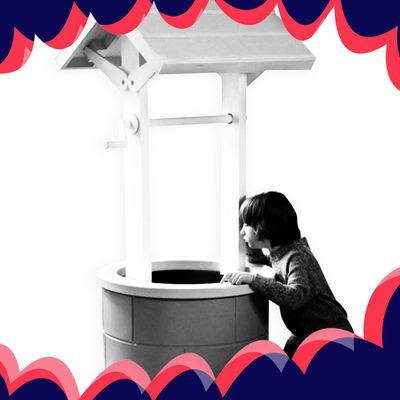
A year ago today, one of the best SNL sketches in recent memory debuted. Titled “Wells for Boys,” it started humbly enough, seeming like just another one of the show’s commercial parodies. What followed, however, was something incredibly specific: Hilarious, rich, and beautiful, it was instantly recognizable as the work of Julio Torres, a new SNL writer at the time, who had already carved out a niche on the show for tonal, dreamlike comedy. In the year since, that reputation has only grown — thanks to this season’s “Papyrus” — making him one of the few writers in the show’s history that fans can spot on sight. Still, “Wells for Boys,” which he co-wrote with Jeremy Beiler, who has since left SNL, is his high-water mark.
Torres and Beiler talk about that sketch during this week’s episode Good One, Vulture’s podcast about jokes and the people who tell them. Listen to the episode and read an excerpt from the transcript of the discussion below. Tune in to Good One every Monday on Apple Podcasts, or wherever you get your podcasts.
Let’s start from the very beginning. What were you like as children?
Jeremy Beiler: I deeply craved attention. That’s the tentpole takeaway from my childhood. Any footage of me as a little boy at any family gathering, I’m following my uncle with the camera and just shoving myself into every shot of every other family member.
Julio Torres: I was very quiet. I was very reserved. I never got in trouble. I don’t think I did anything that warranted discipline. And I would just wait for recess to be over so I could go back to class and sit inside.
JB: Is this painful for you to excavate?
JT: Well, it was going to come out at some time.
What toys did you guys play with?
JT: A lot of Barbies. My favorite was Cinderella Barbie. I had this little Barbie wedding dress that I really liked, and because I used it so much, it was raggedy. I loved how torn it was, and I would put a Barbie with no shoes in it and have her wander about the garden, just thinking about what happened to her and how she got to this point. Also, my mother’s an architect and we would design houses out of cardboard. I loved like circular windows and little French doors.
JB: I was somewhat more boilerplate. I had a little cars and fire truck I really liked.
JT: I didn’t play a lot with cars, but I did have those tiny little cars that you could get at like gas stations for very cheap. I would put them all in a row and I would play “traffic.” I would move them centimeters or like millimeters at a time and they were stuck in traffic.
JB: I had like a doctor’s stethoscope and a doctor’s headlamp that I remember really liking.
JT: Like a Bugs Bunny doctor. You like things about pilots, things about doctors. Jeremy loves writing things that in airplanes, hospitals, and funerals.
JB: I write a lot of sketches in sterile environments. I don’t know what those have in common exactly.
JT: Risk. Death.
JB: I do love writing about death. And I loved playing with death as a child.
Julio, you also had a makeshift well, if you want to explain what that is.
JT: There was one small house we had when I was growing up, with this little backyard and an empty pot that collected water. I would gently caress it when I needed it, I guess.
What moved it from a thing in your life to a thing on television?
JT: I had never tried a commercial parody before, because if left to my own devices, I would always make little movies that aren’t necessarily parodies of anything. Then I remember where we are.
JB: We toyed with versions of it that were basically short films. Unfortunately this one had to be on SNL, so.
JT: I don’t know how the idea popped into my head, but I know it was there for awhile. The seed of it was some stand-up joke that never worked about a kid with a well, and then it’s like, “Oh, it’s funny if it’s a product for sale at Toys ‘R’ Us.”
JB: In that big bubbly plastic. And the idea that there’s an actual missed market. Because we found a new corner of a market, thousands of these boys, that we can make money off of.
Is the nature of the partnership Jeremy making Julio expand on something?
JT: In a lot of cases it is like that, but it’s always finding ideas that no one else would find feasible or funny. I’ve certainly written things with you that no one else was remotely interested in.
JB: We do that pretty well, too. It’s different with each one, but Julio will bring a brilliant idea for a short film, and one of my only contributions to the well is, “Let’s make it a little more commercially.”
There’s a line about the boy having a passionate creative life, but obviously that’s in the future. What made you think, “Oh, it needs that because otherwise it would be a very sad sketch?”
JT: I think that came from me reassuring my parents in the past, because I know that my father was so very worried that I would never come out of my mother’s skirt and never be a functional person. So this was sort of like, “It’ll be fine but not for awhile. You have to just wait.”
JB: Didn’t it say, “You have to wait for adulthood?”
JT: Yes, and that is something that I always felt that I did.
Other than a balcony and broken mirror, were there other possible toys?
JT: I can’t remember if there was another line, but I do remember there was a Philip Glass button on the well that didn’t make it.
JB: There was a little plastic button on the side of the well with a little music note on it and it just played a little toy piano version of Philip Glass. We cut it because it looked a little awkward and sounded weird.
It’s famously hard to end sketches, and the last line is perfect in being funny and maintaining the story. What was your hope with that last joke?
JT: It was very important to have that line because it’s not a sketch about gayness. So it’s not like, “Oh, just give him a Barbie and let him play with dresses and he’ll be fine.” It’s about being different and isolated in a bigger sense. It’s isn’t just that.
JB: It could be that, it doesn’t necessarily have to be.
JT: That little boy could be an atheist.
It struck a chord with people. There was a headline, “Wells for Boys Nails the Loneliness of Queer Kids.”
JB: That’s why we set out to write this. We were hoping for an Advocate piece and we got it.
JT: We’ve gotten so many dates out of it.
How do you feel when people ascribe an agenda to the sketch?
JT: Well, it was written by two gay writers whose otherness is linked to their sexuality — but I don’t think it’s exclusively for that agenda or that purpose. Obviously, it’s connected to it.
JB: It’s nice to see any response to any sketch, let alone someone who you feel gets it in that way.
People who lived that childhood were like, “This is a piece of art that expresses something in a medium in which you don’t usually see it expressed.”
JB: Someone on set, I don’t remember who it was, but she just grabbed out arm and said, “Thank you. I have a sensitive boy.”
How did you feel producing this sketch in a moment when people expect only topical satire from SNL? Do you feel pressure to respond to whatever these times are?
JT: If you look at a breakdown of the show, SNL had a lot of strong political pieces that were very memorable, but a lot of it wasn’t political. So no, I don’t think I felt pressure to be political, especially when there were so many great people doing that very well.
JB: I felt fortunate to be at SNL because if you have something that you’re personally struggling with, you can turn it to a sketch that’s actually funny. It’s a special place. It feels therapeutic to process the world through writing a sketch. I looked for opportunities for that, but I didn’t always find them. I’m also just always looking for what’s fun and what floats my boat.
Where is the well now?
JT: That’s a good question, I was wondering that this morning.
JB: You should own that.
JT: I’m looking for a studio apartment so probably not. I’d like to think that it’s safe somewhere.
JB: I wonder if they just put it in a dumpster.
JT: No, no they wouldn’t. Not the well from “Wells for Boys.” We keep every goddamn wig that anyone’s ever used.





